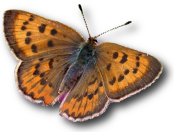 Art Shapiro's Butterfly Site
Art Shapiro's Butterfly Site
Monitoring butterfly populations across Central California for more than 35 years… Introduction
What can butterflies tell us about spring?
The patterns of weather and climate that define the world we know are always changing, from year to year and over much longer time scales as well. The role that human beings have in shaping the climate is much discussed in the news, and often the question being asked is: how will a changing climate affect us?
The point of this lesson is to think about a related but very different question: how might a changing climate affect non-human animals and plants, butterflies in particular?
In order to answer that question we need to understand something about how butterflies are affected by the weather. After reading an introduction below, you will take some real data and investigate butterfly behavior and weather patterns for yourself.
I. Organisms and Phenology
All living things have certain conditions in which they thrive. For example, there are many kinds of plants and animals that can only be found living on mountains, but not in valleys or deserts. Why? The answer will be different for each animal, but in general plants and animals that live on mountains may need cooler temperatures and more rain (mountains are often a bit colder and wetter than other places). Similarly, there are organisms that are well suited to life in some environments that seem to us completely inhospitable, such as the bottom of the sea or deep under ice.
Just as plants and animals have certain environments, habitats, or parts of the earth in which they do best, there are also certain times of the year which are most favorable. For example, many plants grow and flower in the Spring but not during Summer -- this is particularly true in dry climates where most of the rain falls in the Spring. Most organisms adjust their lives to take advantage of conditions that are only available at certain times of the year. The study of the timing of natural phenomena is called phenology. We are going to discuss the phenology of butterflies, but first we need to know a few things about the climate.
II. Climate
We experience weather in seasons. Different parts of the earth have very different seasons -- in some places there are four distinct seasons, while in other places there are only two seasons, a wet season and a dry season. No matter where you live, you may have the feeling that the seasons are very predictable: when nights get cooler and leaves fall from trees, for example, Summer is probably over.
However, we have learned that the seasons are not necessarily the same from year to year in two important respects. On the one hand, the timing of seasons can change through time, and the conditions that define the seasons can also change. By conditions, we mean a number of environmental characteristics, including temperature and rainfall.
In addition to changes from year to year, temperatures around the world have been increasing throughout the 20th century: global temperatures appear to have increased by just less than one degree Celsius. That number is an average from many different places, some of which have gotten much warmer and some have actually gotten colder. Patterns of rainfall are also complicated, as some areas are getting drier and some wetter.
There is general agreement that byproducts from modern civilization have caused these long-term changes. However, the cause of climate change is not the focus here -- we are interested in the fact that weather patterns can change over time, and that each year may be very different from the one before it or the one after it.
III. Climate and Butterflies
Let's imagine a butterfly living in California, in the Central Valley, where summers are hot and dry, and winters and cool and wet. Adults of this species can be seen flying in April, May, and into the first part of June. During that time, adults will visit flowers with nectar, mate, and females will lay eggs on host plants. In a couple of weeks, larvae will hatch and begin eating a plant (called a "host plant"). If they consume the plant on which they hatched, they will have to forage for more plants.
After another couple of weeks, larvae will pupate, sometimes in a protected location at the base of a host plant or under a rock. By now it is the middle of Summer, host plants have dried up for the season, and the pupae will remain hidden until the following spring. Environmental cues, such as increasing temperatures in the following Spring, will tell the pupae that is time to emerge as adults and begin the annual cycle again.
Consider the life cycle just described from a climatic perspective. There are many, many places in which the activities of butterflies (at all life stages) may be extremely dependent upon the weather. For example, if there are not enough sunny days while adults are flying, some of them may fail to mate and lay eggs. If conditions in Summer become too hot and dry too fast, plants could dry up before larvae complete develop (which could actually lead to local extirpation of a butterfly population). So it is not too difficult to imagine ways in which butterfly populations may be extremely sensitive to changes in weather, but how sensitive? This is a question that ecologists have only begun to answer in recent years. Follow the activities link to investigate the question for yourself: